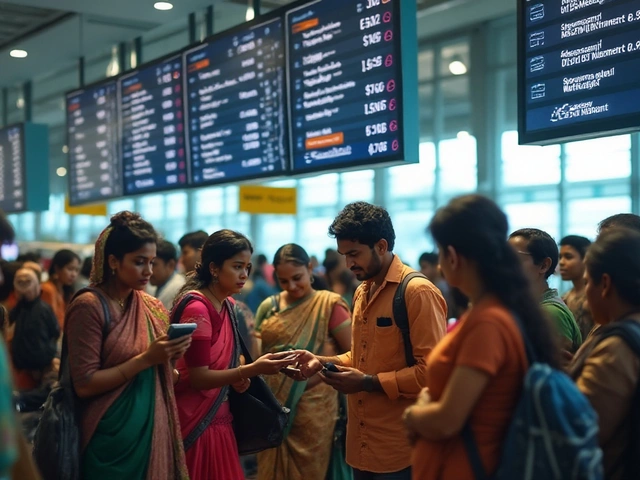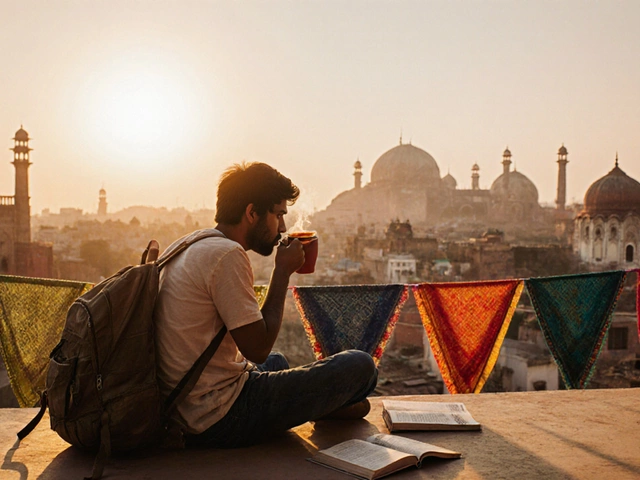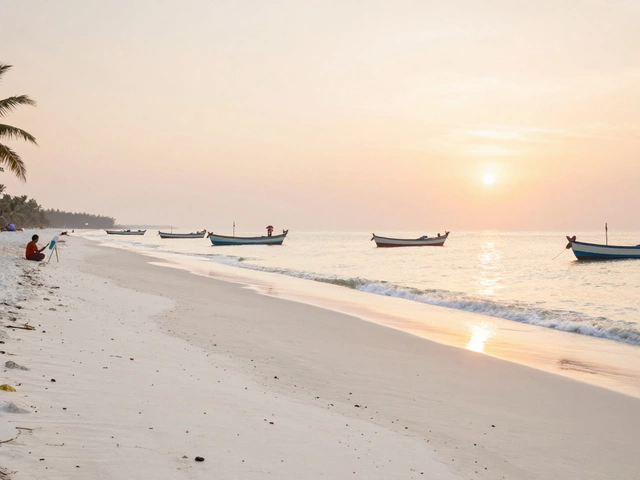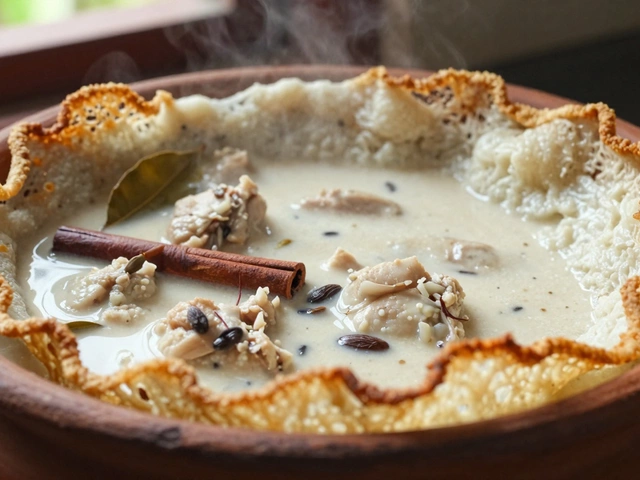Ever wondered if 10,000 rupees can cover your travel escapades in India? You're not alone! This modest sum can indeed open doors to an unforgettable experience, but it requires a bit of planning. India is diverse, both culturally and economically. The cost of things varies wildly from bustling metros to serene rural areas, and knowing how to stretch your currency is key.
First, let’s delve into what 10,000 rupees can get you. In big cities, it might vanish faster than a fleeting weekend, while in rural parts, it could last for days. It's all about knowing where to save and where to splurge. Trust me, with the right strategy, you'll be able to savor street foods, comfy beds, and even a few splurges without burning a hole in your wallet.
- Understanding the Value of 10,000 Rupees
- Where to Stay on a Budget
- Getting Around Without Breaking the Bank
- Tasting Indian Food on a Dime
- Affordable Cultural Experiences
- Smart Budget Tips for Travelers
Understanding the Value of 10,000 Rupees
So you're holding 10,000 rupees and wondering how far it'll take you in India. Well, let's break it down. This might not sound like much, but in India, it can actually go a long way—especially when you're smart about it.
Imagine staying in a cozy guesthouse in a small town for about 500 to 1,000 rupees per night. If you're backpacking across India, you're in luck because accommodation doesn't always cost a fortune. Moving on, street food is another wallet-friendly delight. A scrumptious plate of chole bhature or dosa might cost you just around 50 to 150 rupees. It's delicious and you get to enjoy an authentic taste of India!
Here's a quick snapshot of how expenses add up:
| Category | Approximate Cost (in Rupees) |
|---|---|
| Guesthouse Stay (per night) | 500-1,000 |
| Street Food Meal | 50-150 |
| Local Transport (per day) | 100-300 |
| Entry to Local Attractions | 10-500 |
Now, public transport is your best friend when it comes to budget travel. Auto-rickshaws, cycle rickshaws, and buses are super cheap. For short distances, like a quick trip within a city, expect to pay between 10 and 50 rupees.
Let's put this into perspective. With a smart mix of affordable sleeping arrangements, tasty street food, and budget transport, you can really make those 10,000 rupees stretch further than you think. Remember, the key is blending into the local style and picking places where your rupees are welcomed with open arms!
Where to Stay on a Budget
Finding a place to rest your head without emptying your wallet is totally achievable in India. In fact, India offers a range of budget travel accommodations that are pocket-friendly yet comfortable.
If you're in urban areas, consider hostels. They’ve become quite popular in cities like Delhi, Mumbai, and Bangalore, offering beds for as low as 500 rupees a night. Some well-known chains like Zostel and GoStops provide a cozy environment with a chance to meet fellow travelers.
For a more localized experience, guesthouses in smaller towns are your best bet. These places often charge between 300 to 800 rupees a night. They're great for soaking in local culture and you often get home-cooked meals too, which are both cheap and delicious.
If you're adventurous and looking to save even more, Couchsurfing is an option. It's free and offers an authentic experience staying with locals who can offer valuable travel tips.
Here’s a handy breakdown:
| Accommodation Type | Average Price (Per Night) |
|---|---|
| Hostel | 500-800 INR |
| Guesthouse | 300-800 INR |
| Mid-range Hotel | 1000-2000 INR |
Keep an eye on travel apps like OYO and MakeMyTrip, which often have discounts and deals on various stays. Using these platforms, you might snag a decent room for a fraction of its regular price, making your budget travel India experience even sweeter!
Getting Around Without Breaking the Bank
So, you're looking to explore India without spending your whole stack of 10,000 rupees on transportation. Smart move! Luckily, India offers plenty of budget-friendly travel options that fit the bill for every adventurer.
Let's talk trains. Indian Railways is a classic way to travel and its extensive network covers almost every nook and cranny of the country. Booking a seat in a sleeper or general class can be incredibly cheap. Imagine traveling from Mumbai to Goa for just about 500 rupees – talk about a bargain! Just remember to book your tickets in advance, especially during peak seasons.
Prefer something with a little more legroom? Buses in India are a great alternative. Private and state-run options vary in comfort and budget. For just a few hundred rupees, you can hop onto a state-run bus and watch the countryside zoom by. It's not the most luxurious experience, but definitely wallet-friendly!
Now, city travels are another ball game. If you're in a major city, using metro or local trains can save you a ton. Cities like Delhi and Mumbai have efficient metro systems that can whizz you from one end to another for under 50 rupees. And hey, sometimes that’s faster than a taxi stuck in Delhi traffic!
For quick trips, consider using ridesharing apps like Ola or Uber. They often have promotions or discounts, making them cheaper than traditional cabs. Don't forget auto-rickshaws! Just be sure to haggle a bit or insist on the meter rate to avoid getting overcharged.
Here's a quick snapshot of typical costs:
| Mode of Transport | Estimated Cost (Rupees) |
|---|---|
| Train (Sleeper Class - 500 km) | 300 - 700 |
| Bus (State-Run - 200 km) | 200 - 400 |
| Metro Ride (Per Ticket) | 10 - 50 |
| Auto-Rickshaw (City Center to Suburbs) | 80 - 150 |
Budget travel in India is all about mixing and matching these options. So grab your map, keep your budget in check, and enjoy the vibrant landscape this incredible country has to offer!

Tasting Indian Food on a Dime
If you're out to experience the vibrant flavors of India without spending a fortune, you're in luck. Let's face it, Indian street food is a paradise for budget travelers, and it’s tasty enough to give fancy restaurants a run for their money!
First off, let's talk about the essentials—budget travel India and eating local. Street vendors are your go-to for real, flavorful meals. Think crispy samosas, spicy pav bhaji, and refreshing sugarcane juice. Prices for these delights often start as low as 10 rupees. No kidding. Just remember to hit up places buzzing with locals—that's your best seal of approval for hygiene and taste.
Of course, there are other options if street food isn't really your scene. Budget eateries, known as 'dhaba,' offer hearty meals that won’t break your bank. You can enjoy a filling meal, complete with rice, dal (lentil soup), and a couple of veggie dishes for around 100 to 150 rupees. It doesn't get more affordable than this!
And for a bit of culinary adventure, try a thali—a platter with a little bit of everything, from curries to pickles. Thalis are fantastic for tasting diverse flavors in one go and usually cost around 200 to 300 rupees in more casual settings.
Want a quick snack? Here are a few must-tries:
- Vada Pav: Essentially a spicy mashed potato filling sandwiched between buns. Costs about 15-20 rupees each.
- Chole Bhature: Spicy chickpeas with fluffy fried bread, usually priced around 50-70 rupees.
- Pani Puri: Hollow, crispy balls filled with flavored water and tangy tamarind. You can get a plate for just 30 rupees.
If you’re a fan of sweets, you can grab a juicy jalebi or a syrupy rasgulla for as little as 10-20 rupees. Remember, polished restaurants are great for certain experiences, but to truly experience authentic tastes while saving money, dive into local eateries and street corners.
Affordable Cultural Experiences
India's rich cultural tapestry can be explored without thinning your wallet. There are countless ways to soak up the culture on a budget. From visiting ancient temples to participating in local festivals, your journey through India can be both enriching and cost-effective.
One of the simplest pleasures in India is its vibrant festivals. If you plan your trip around Holi or Diwali, you're in for a treat. Join in these festivities and experience joy that’s both immersive and free! If you’re in the right place at the right time, local celebrations can offer you a front-row seat to traditional music, dance, and rituals without spending a dime.
"The vibrancy of India's culture is unparalleled. Even with limited funds, there's a wealth of experiences waiting for every traveler," says Shashi Tharoor, a well-respected author and politician.
Don't miss the local museums and art galleries. Many cities have free or low-cost entry fees, offering glimpses into India's history and art. For instance, the Salar Jung Museum in Hyderabad, with its modest entrance fee, houses one of the largest art collections in the world.
The architectural beauty of India is also something to behold, and often it doesn’t cost you a cent. Take a wander through Jaipur’s Pink City, explore forts in Rajasthan, or admire the colonial architecture of Mumbai. With a camera in hand, these places make for picture-perfect memories.
- Street performances: Many cities have talented street artists performing music, dance, and theatrical pieces. Keep an eye out for these free performances, especially in tourist hubs.
- Local tours: Opt for community-guided tours that often charge a small fee, allowing you to support the locals while getting authentic insights.
- Markets: Indian markets like Dilli Haat or MG Road in Goa are a cultural spectacle, reflecting the diversity in food, crafts, and people.
And if you're feeling really adventurous, why not attend a yoga retreat session or meditation workshop? Many places offer budget day passes, with Ashrams in Rishikesh being particularly well-regarded.
This approach to affordable experiences not only makes your trip memorable but also allows you to connect with India's heart and soul without needing to overspend.
Smart Budget Tips for Travelers
Alright, so you're planning to explore India with a pocketful of 10,000 rupees and want to make every cent count. It's totally doable! Traveling smart and saving up on costs requires a bit of know-how and some creativity.
First up—timing is everything. Did you know traveling during the off-peak tourist season, like monsoon months, can slash accommodation prices in half? This may not sound appealing to everyone but it means fewer crowds and cheaper rates.
Accommodation is where a chunk of your money can go, so why not try homestays or hostels? They offer budget-friendly options and bonus: you get to mingle with locals and travelers alike. This gives you a richer experience than staying in a hotel.
The legendary explorer, Paul Theroux, once said, "Travel is glamorous only in retrospect," which is true when you're budgeting. Forget what looks good on Instagram and focus on core experiences. Street food, for example, is a delightful way to savor authentic flavors without draining your cash. Grab a vada pav in Mumbai or a masala dosa in Chennai for under 50 rupees!
"Travel is glamorous only in retrospect." - Paul Theroux
Transport is another area to keep an eye on. Make the most of India's extensive train and bus networks. Book tickets in advance for discounts and enjoy the scenery. If you're city-hopping, consider overnight trains that save on a night's accommodation.
Here are some practical tips to squeeze out the best from your budget:
- Carry a reusable water bottle to avoid purchasing bottled water frequently.
- Research free or donation-based attractions, like local temples and street markets.
- Track your expenses with a simple app to ensure you stick to your 10,000 rupees budget.
Lastly, a great way to dive deeper into culture without spending much is volunteering. In exchange for a few hours of work a day, many organizations provide free meals and a place to stay.
So there you have it, wandering India under 10,000 rupees is not only possible but also incredibly rewarding. It's all about hustling smart and embracing the adventures that come your way!








